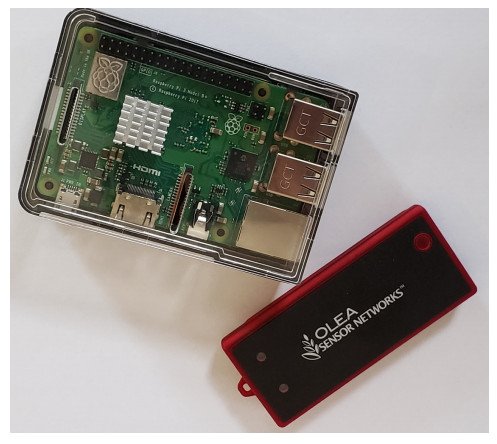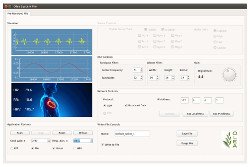Olea Sensor Networks’ “OS-3010” healthcare sensor module now works with the Raspberry Pi and other Linux and Android devices. A 24GHz Doppler Radar Sensor monitors heart rate, respiration, and other signals synthesized by OleaSense software.
Reno, Nevada based Olea Sensor Networks Sensor makes a variety of sensors and sensor boards for healthcare, industrial safety, and in-vehicle use. It released its OS-3010 wireless healthcare sensor board earlier this year for Windows and has now updated it to support Linux and Android platforms, with a Raspbian version of its OleaSense software designed to work on the Raspberry Pi.
The 84 x 35 x 8.7mm, 29-gram OS-3010 is fully enclosed and designed to fit in the pocket or badge-holder of a medical professional or patient. It can also be attached to a patient’s bed for continuous monitoring. (The device complies with ETSI 300 440 and FCC 15.24 standards, but is not currently certified for clinical use.)
The lightweight, non-intrusive OS-3010 can “free the patient from traditional, restrictive methodology such as Holter Monitors or Spirometers,” says Olea. It can reduce the need for healthcare professionals to continually take and record patient data while avoiding user input errors. It also enables easy, long-term in-home monitoring, says the company.
The OS-3010 could act as an affordable solution for improving rural healthcare in developing countries, says Olea. One can imagine a custom solution for field healthcare worker that combines the OS-310 with a Raspberry Pi and touchscreen for mobile healthcare.
The OS-3010 communicates with host systems such as the Pi by way of its Bluetooth 4.2 radio and micro-USB port. It runs on a Cortex-M4 MCU and integrates a 16-bit data acquisition (DAQ) interface and an Olea Vital-Sign Sensor — a 24GHz (K-Band) CW Doppler radar sensor. Other features include a magnetometer, accelerometer, gyroscope, and LED.
The OS-3010 consumes 200mW (40mA at 5V) and ships with an up to 8-hour, 150mAh Li-ion battery. There’s also a wall adapter and optional in-vehicle adapter. The device supports -40 to 85ºC temperatures.
The OS-3010’s Olea Vital-Sign Sensor works without contact with the patient’s body. Combined with the OleaSense software, the sensor can remotely aggregate and analyze patient data and extract actionable real-time information. It gathers vital sign data such as respiration rate, blood pressure, heart rate, and Heart Rate Variability (HRV) data.
The OleaSense Platform software uses ML algorithms to analyze and aggregate sensor data, and present actionable data about a patient’s condition in real-time. The software can create an “advanced statistical index that has the capability to predict declining health in a monitored patient,” says Olea.
Pre- and post-processing algorithms include digital filtering, advanced signal processing, real-time vital sign statistical processing, peak detection and feature extraction algorithms, pattern recognition and machine learning algorithms, and sensor fusion algorithms. OleaSense also includes an authentication engine that can identify an individual’s unique heartbeat identifier, which Olea calls a HeartSignature.
OS-3010 and OleaSense-driven QSN Quadcorder dashboard screens on Linux (left) and Windows
The OleaSense software is made available via a “Star Trek like” dashboard visualization GUI called the QSN Quadcorder. Available for Linux, Android, and Windows, the software summarizes and plots data processed by Olea sensors.
Olea Sensor Networks is collaborating with the University of Bari, Italy to study how Olea’s sensor solution can complement long-term remote monitoring of patients. Under the direction of Dr. Loreto Gesualdo, Head of the Nephrology, Dialysis and Transplantation Unit at the University, the researchers will investigate the use of OleaSense in providing statistical data for analysis of conditions such as the mild cognitive impairment (MCI) of patients with chronic kidney disease (CKD). They are also looking into how the HKV sensor can help understand Autonomic Dysfunction in Mild Cognitive Impairment.
Other Raspberry Pi related healthcare monitoring devices include ProtoCentral’s $195, open source HealthyPi HAT add-on for vital sign monitoring, including ECG/respiration, pulse oximetry, and temperature. Last year, Warp United released a SanStar WS-3A SBC version of its handheld Warp 3 Medical Recorder. Like the handheld, it runs Android 5.1 on a Rockchip RK3288, and offers WiFi, BT, and cellular radios.




